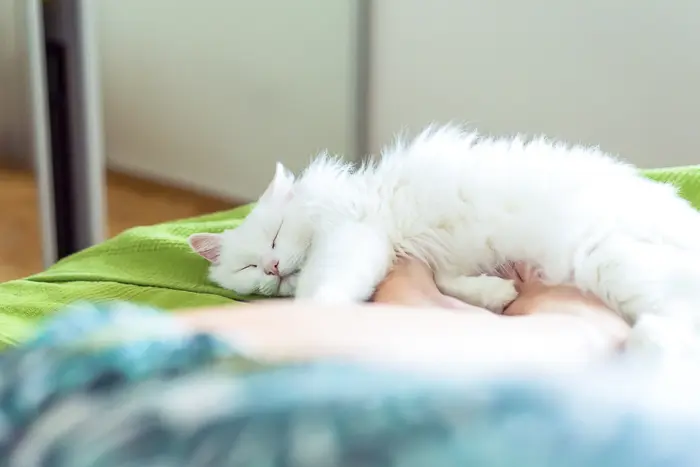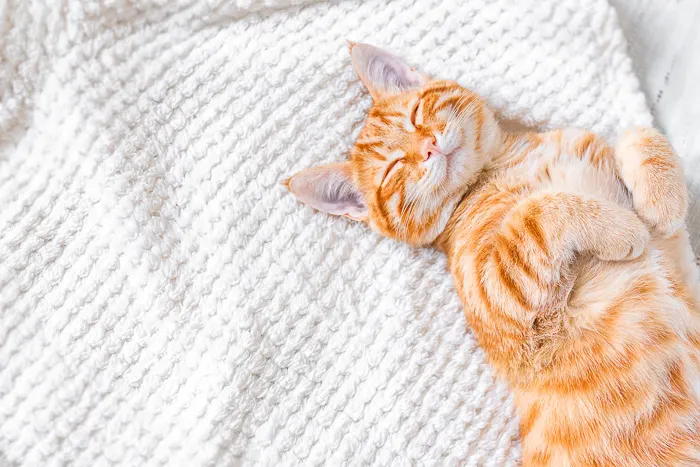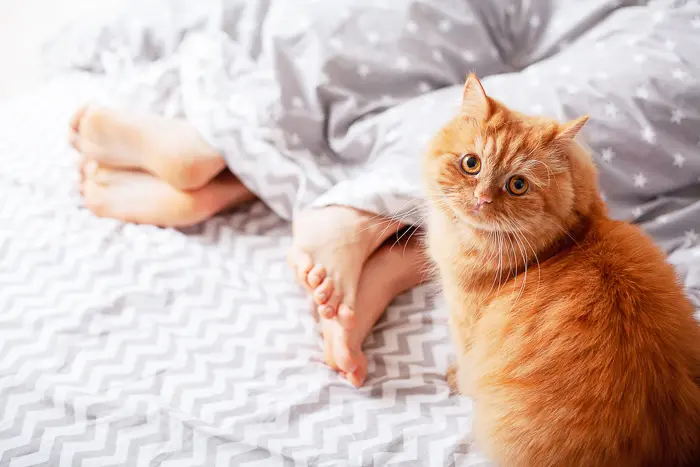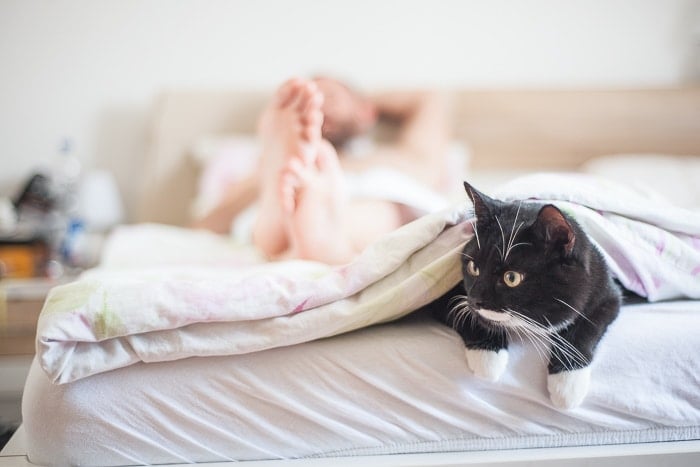You've likely heard of cat naps, and lazy cats, and sunbathing cats, and snoozing cats. What are normal and healthy cat sleeping behaviors? Should you be worried about your own feline friend? Dr. Jess addresses some of the most common cat sleeping questions below:

How Long Do Cats Normally Sleep?
Just like humans, cats normally sleep for different amounts of time, it depends on the individual. However, there is an average range of normal sleeping hours most cats fall into during a 24 hour day.
Most cats, on average, sleep between 12 and 18 hours per day. Studies have shown us that the older a cat gets, the more sleep they tend to want and need [source].
A sleeping kitten can snooze for up to 20-22 hours per day.
That being said, it is highly unlikely that your cat will snooze for that long in one large chunk.
It is much more of a probability that your furry friend will take a couple hours long snoozes here and there.
So why is that?
Why Do Cats Sleep So Much?
Cats seem to sleep a lot to us. As humans, we are considered diurnal – we are awake and most active, naturally, during the day.
But cats are a little bit different than us here.
Cats are considered crepuscular. This means that they are awake and most active at dawn and dusk.
Many other animals, such as the rabbit, the hamster, and the chinchilla, are also considered to be crepuscular in nature. So cats aren't the only odd-balls here!

Is My Cat Actually Sleeping?
It may be sometimes hard to tell if your cat is actually sleeping or not.
Cats can experience strange-looking eye movements during their slumber [source 1, source 2] just like humans, so it may seem that they are awake.
Their limbs may move as if they are dreaming of chasing something. They may make noises as if calling to someone.
But these things may all occur while your furry feline friend is completely asleep, and most likely pretty deeply asleep.
What is a Catnap?
A catnap is a term that many people use to describe a generalized nap session held during the day, typically a shorter-term nap. A 20 – 30 minute catnap can have many benefits, including potentially reliving drowsiness!

Why Do Cats Sleep Next To You or On You?
Your cat really likes the human that they have bonded with.
Whether it is the person who feeds them, who gives them attention and pets, them, or who makes them feel the safest, your cat will likely want to curl up next to the warm body that they have a connection with the most. Congrats! They feel safe with you!
Many times, you can observe Fluffy at the foot of your bed, while other times, they like to wrap themselves up on your pillow, around your head.
Still, other cats are more of a lap cat, and like to cuddle you while you are sitting upright in a chair or on the couch.
While other cats, are more independently-willed, and just like a hnd or arm next to them while they snooze – any more than that would be too much for them.
Are There Common Cat Sleeping Positions?
There are some more common sleeping positions for cats.
Your feline friend may tend to sleep more consistently in a few of these positions, depending on their preference, just like how humans have a preference in if they sleep on their back or their sides.
Curled up in a Ball:
This position helps the cat in more than one way.
First off, it helps protect those vitals organs from harm's way, because those vital organs are all curled up in the inside of that fur ball snoozing.
Secondly, when your cat is all curled up all cute and cuddly, they are also holding in a lot of homemade heat. What a great way to conserve heat and energy!
Laying on Their Back:
If your cat is laying on their back and their belly is up, showing off their abdomen to the world, then you should feel oh so good.
This is because your cat feels so safe and secure that they can let their vital organs out on full display and not worry that they will come under attack.
For a cat, showing their bellyside off means giving off a huge amount of vulnerability and risking their overall safety.
So if your cat can sleep in this position – feel good in that your cat feel very safe in their environment that you have provided them!
Laying on Their Side:
When your cat sleeps on their side, it is very similar in thought as when they are sleeping on their backs, bellies up.
They have their bellies and organs partially exposed – so they are quite relaxed and stress-free when it comes to feeling safe.
No worries in the world will allow them to sleep soundly on their sides.
Legs Tucked Under – Loaf:
When your cat is sleeping in the bread loaf position, chances are, that they will not be sleeping in that position for long.
Most cats will take a snooze in this position for a short amount of time, say a catnap, and then move on with their day.
If your cat is committing to a longer sleep session, they will likely move on to a different sleeping position.
Paws Covering Their Eyes:
When your cat covers their eyes with their paws, they are making a valid attempt to sleep.
Whether they are trying to block out the bright daylight while in slumber, or just tune out their environment surrounding them, placing their cute little paws on their face sometimes seems like the best way to combats the noisy outside world.
Contortionist:
There is no real rhyme or reason to this position. If your cat is feeling loosey-goosey and is also primed for a nap, some cats will just fall asleep as they lay, tied up all wonky or pretzel-like.

When to Worry About Your Cat's Sleeping Behaviors:
If your cat suddenly changes their sleeping habits of any kind, note the abrupt change, and contact your veterinarian to see if they believe the change should be of a concern.
Your vet may ask to see your cat to make sure that they are healthy and that no health concerns are occurring internally, where you can't see.
If your cat stops or changes their other daily needs, such as changes in eating, drinking, or bathroom habits, it may affect their sleep.
This problem also needs to be addressed by your veterinarian.
Cat Sleeping Summary:
Cats need sleep just like all other mammals. And they need a lot of it.
Most cats will break up their hours of sleep into smaller snooze sessions throughout a 24-hour period.
Cats who sleep more or less than the 12-18 hours could be completely normal, but it could also be a sign that something is wrong.
If any of your cat's sleeping habits suddenly change, contact your veterinarian immediately for directions on what to do next – it could mean that there is a health issue.

![[Vet Explains Pets]](https://vetexplainspets.com/wp-content/uploads/2024/09/cropped-vetlogo-199x66.png)
